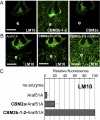Carbohydrate-binding modules promote the enzymatic deconstruction of intact plant cell walls by targeting and proximity effects
- PMID: 20696902
- PMCID: PMC2930570
- DOI: 10.1073/pnas.1005732107
Carbohydrate-binding modules promote the enzymatic deconstruction of intact plant cell walls by targeting and proximity effects
Abstract
Cell wall degrading enzymes have a complex molecular architecture consisting of catalytic modules and noncatalytic carbohydrate-binding modules (CBMs). The function of CBMs in cell wall degrading processes is poorly understood. Here, we have evaluated the potential enzyme-targeting function of CBMs in the context of intact primary and secondary cell wall deconstruction. The capacity of a pectate lyase to degrade pectic homogalacturonan in primary cell walls was potentiated by cellulose-directed CBMs but not by xylan-directed CBMs. Conversely, the arabinofuranosidase-mediated removal of side chains from arabinoxylan in xylan-rich and cellulose-poor wheat grain endosperm cell walls was enhanced by a xylan-binding CBM but less so by a crystalline cellulose-specific module. The capacity of xylanases to degrade xylan in secondary cell walls was potentiated by both xylan- and cellulose-directed CBMs. These studies demonstrate that CBMs can potentiate the action of a cognate catalytic module toward polysaccharides in intact cell walls through the recognition of nonsubstrate polysaccharides. The targeting actions of CBMs therefore have strong proximity effects within cell wall structures, explaining why cellulose-directed CBMs are appended to many noncellulase cell wall hydrolases.
Conflict of interest statement
The authors declare no conflict of interest.
Figures




Similar articles
-
Differential recognition of plant cell walls by microbial xylan-specific carbohydrate-binding modules.Proc Natl Acad Sci U S A. 2006 Mar 21;103(12):4765-70. doi: 10.1073/pnas.0508887103. Epub 2006 Mar 14. Proc Natl Acad Sci U S A. 2006. PMID: 16537424 Free PMC article.
-
Understanding how the complex molecular architecture of mannan-degrading hydrolases contributes to plant cell wall degradation.J Biol Chem. 2014 Jan 24;289(4):2002-12. doi: 10.1074/jbc.M113.527770. Epub 2013 Dec 2. J Biol Chem. 2014. PMID: 24297170 Free PMC article.
-
Enzymatic treatments reveal differential capacities for xylan recognition and degradation in primary and secondary plant cell walls.Plant J. 2009 May;58(3):413-22. doi: 10.1111/j.1365-313X.2009.03785.x. Epub 2008 Jan 6. Plant J. 2009. PMID: 19144002
-
Advances in understanding the molecular basis of plant cell wall polysaccharide recognition by carbohydrate-binding modules.Curr Opin Struct Biol. 2013 Oct;23(5):669-77. doi: 10.1016/j.sbi.2013.05.005. Epub 2013 Jun 13. Curr Opin Struct Biol. 2013. PMID: 23769966 Review.
-
Plant protein inhibitors of cell wall degrading enzymes.Trends Plant Sci. 2006 Jul;11(7):359-67. doi: 10.1016/j.tplants.2006.05.006. Epub 2006 Jun 13. Trends Plant Sci. 2006. PMID: 16774842 Review.
Cited by
-
Novel characteristics of a carbohydrate-binding module 20 from hyperthermophilic bacterium.Extremophiles. 2015 Mar;19(2):363-71. doi: 10.1007/s00792-014-0722-1. Epub 2015 Jan 10. Extremophiles. 2015. PMID: 25575613
-
The unique architecture and function of cellulose-interacting proteins in oomycetes revealed by genomic and structural analyses.BMC Genomics. 2012 Nov 9;13:605. doi: 10.1186/1471-2164-13-605. BMC Genomics. 2012. PMID: 23140525 Free PMC article.
-
The lectin domain of the polypeptide GalNAc transferase family of glycosyltransferases (ppGalNAc Ts) acts as a switch directing glycopeptide substrate glycosylation in an N- or C-terminal direction, further controlling mucin type O-glycosylation.J Biol Chem. 2013 Jul 5;288(27):19900-14. doi: 10.1074/jbc.M113.477877. Epub 2013 May 20. J Biol Chem. 2013. PMID: 23689369 Free PMC article.
-
Current challenges in designer cellulosome engineering.Appl Microbiol Biotechnol. 2023 May;107(9):2755-2770. doi: 10.1007/s00253-023-12474-8. Epub 2023 Mar 21. Appl Microbiol Biotechnol. 2023. PMID: 36941434 Review.
-
The extracellular endo-β-1,4-xylanase with multidomain from the extreme thermophile Caldicellulosiruptor lactoaceticus is specific for insoluble xylan degradation.Biotechnol Biofuels. 2019 Jun 8;12:143. doi: 10.1186/s13068-019-1480-1. eCollection 2019. Biotechnol Biofuels. 2019. PMID: 31198440 Free PMC article.
References
-
- Harris PJ. Diversity in plant cell walls. In: Henry RJ, editor. Plant Diversity and Evolution: Genotypic and Phenotypic Variation in Higher Plants. Wallington, Oxfordshire, UK: CAB International Publishing; 2005. pp. 201–227.
-
- Knox JP. Revealing the structural and functional diversity of plant cell walls. Curr Opin Plant Biol. 2008;11:308–313. - PubMed
-
- Mohnen D. Pectin structure and biosynthesis. Curr Opin Plant Biol. 2008;11:266–277. - PubMed
Publication types
MeSH terms
Substances
Grants and funding
LinkOut - more resources
Full Text Sources
Other Literature Sources

